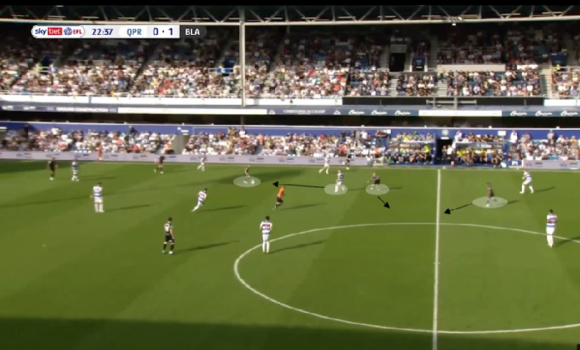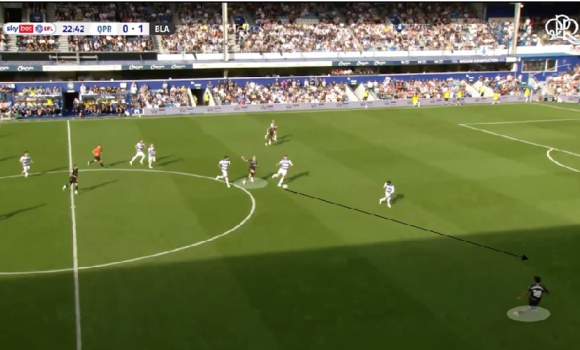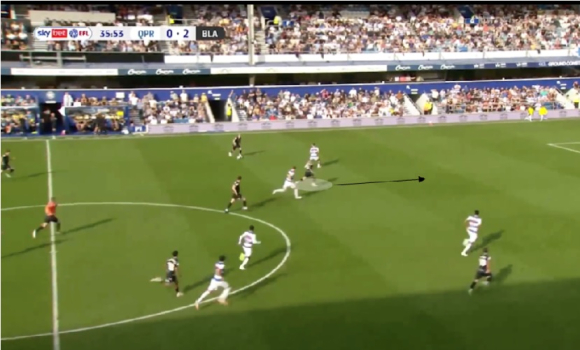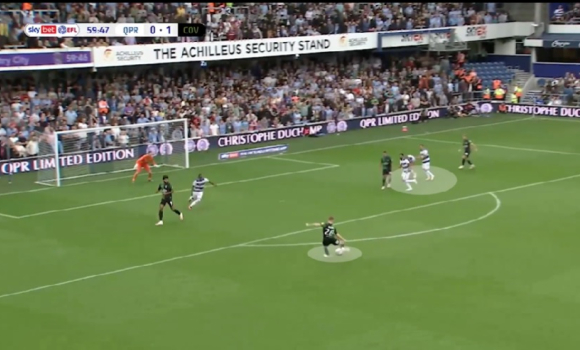QPR’s consistent, persistent failures out of possession – Analysis Sunday, 15th Oct 2023 18:38 by Dan Lambert Dan Lambert’s first LFW deep dive of the 23/24 season looks into why, even after a summer to work on it and the addition of experienced goalkeeper, central defenders and a defensive midfielder, the team is continuing to ship bucket loads of amateur hour goals. We’ve reached the second international break of the season, and QPR sit in the relegation zone, with three defeats from the last three games. Tough opponents in Coventry, Leeds and Blackburn? Yes, but were we poor in all three? Yes, we were. There’s probably far too much to dissect with this QPR side right now, particularly what on earth we are doing going forwards, creating chances etc. But I think after recent games it’s better to focus on this team out of possession… our press, our defending and why we are conceding so many cheap goals so consistently. After all, out of possession, pressing, defending, is stereotypically an “Ainsworth’s speciality”. The suffocating high press, creating opportunities from high turnovers and when then when you are dragged into deeper areas you expect his team to defend their box well, have a tight shape as a unit and fight for one another. I think this is a common misconception with an Ainsworth team, however. Sure you’ll see bodies on the line, blocking shots, very visual defending, but when it comes to the data for defending and chances conceded his teams often concede some of the highest chances (xG against) in the leagues. For the 22/23 season (albeit he joined us in March that season), Wycombe were sixth highest for xG against in League One with 58 xG. That’s a common theme with us now. In games like Birmingham away the visual defending is there with the brave, last ditch blocks by Steve Cook, Sam Field and others, but the defensive data for this season is as bleak as it was on the eye vs Blackburn. We’re the fourth worst for xG against in the league conceding 14.3 in open play and third worst for xG against for set pieces with 4.3. That’s where I’d like to delve deeper today - looking at what’s causing it, what we’re doing/not doing and are there any common themes with the way teams are exploiting us continually. The Blackburn bum gobbingI’ll start with the Blackburn game- looking at our pressing, because from the four goals conceded they began from some form of deep settled possession with the CBs. How we set up to press: Our two strikers would press/go man to man on their 2 CBs. Chair (10) man marks their pivot, our 2 ‘number 8s’ (7 and 8) man mark their CMs and Colback (6) would screen the defence and cover any of Dolan’s movements dropping deep.
Here’s where the pressing triggers would occur. As both Blackburn’s FBs were spare players, they’d often receive the ball. When that happens, as shown, the ball-near-CM in this case Dozzell (7) would press the FB in possession and as he’s doing that Colback would jump onto Blackburn’s CM (7) that Dozzell previously marked. The others (CFs, Chair, CMs etc) would still lock onto their man, but Dolan (9) would be free to operate between the lines with more space.
An example of the trigger: Duke McKenna should be jumping out to press Pickering (LB) but instead runs back in a straight line. Colback, who is having to shift across to Duke Mckenna’s man also has to jump out to the LB to press.
As that sequence showed, there are a load of things wrong with the press/defending. Firstly, the triggers aren’t aggressive enough for the midfielders in the FB areas, then we have players losing their markers in a man to man system, and as a result of that as a knock on effect, we get overloaded in the middle and they are able to attack spaces behind our midfield and in front of our backline, leaving our defenders 1v1 against good attackers/wingers. Another big issue with playing a man to man out of possession system, is the reliance on tracking your runner/man…
Another example where we got cut open far too easily. Failure to track runners the full length of the pitch, and they get a very good chance in our own box from about three passes. Then there comes the fourth goal, arguably the worst and most comical of them all, described by Clive at the time as “not a goal a professional football team should be conceding” and, again, coming from Blackburn’s build-up.
Interesting thing with this move is Pickering, who comes inside on this occasion, never received the ball so was there a need for Duke McKenna to jump from the shape to react, opening up spaces in the middle of the pitch.
So, Blackburn was a real eye opener. The press was poor, poorly executed and we defended incredibly badly as well. As for Leeds, it provided a different test, a more passive one but still the same problems occurred. Leeds, Leeds, LeedsIt’s worth noting for Leeds the shape was different- we set up in a 5-4-1 mid-block and rather than go exclusively man to man, we adopted a more zonal approach within our man to man structure
You’d have thought we’d have maybe adapted our shape, or tweaked our game plan slightly, as Leeds continued to constantly hurt us dangerous areas, but we didn’t really and issues persisted. Leeds accumulated more than 2xG for the evening.
I don’t think I, or anyone, expected anything from that game against Leeds but hoped we could cause some issues in the game or make life difficult for Leeds. But the amount of times Leeds got in between our shape at ease, or the amount of final third entries they had, just summed up the issues out of possession that are persisting, and are causing us to give up numerous high quality chances. Sent to CoventryOur final look is at the 3-1 defeat to Coventry three games ago, and you probably won’t be surprised to see some similar patterns occur, both in the press and defending. For context, this was our pressing structure against Coventry…
This was an extremely risky approach, against a team that beat QPR twice last season and a manager who has seven wins and a draw from eight matches against Gareth Ainsworth sides, but usually those were the triggers. Similar to both Blackburn and Leeds we were isolated on the last line in 1v1 scenarios again, and they were able to break our press quite easily and find space between the lines- which led to goals.
As for the goals, as well as being open in our shape/press, basic errors like tracking runners really cost us in both the goals shown.
Painful, painful goal to concede. As for the final goal…
Allen has the ball on the edge of the box, with space to hit for Simms at the back post.
The ball meets Simms run. Simms scores. Defensively, tracking runners were the main areas of concern in these instances, but it’s also worth mentioning that, as shown throughout this piece, breaking our press so easily to get into the final third led to these scenarios. It’s too easy to say Ainsworth should move to a zonal system. Managers have principles and should stick to them and this is one of Ainsworth’s. I think there’s a discussion on whether the players can maintain this man-to-man press, but we have recruited to bring in greater athleticism over the summer, particularly with Larkeche and Smyth. I think some of the players would suit a more zonal approach, as shown at the end of last season to one extreme, but I also do think the players aren’t carrying the instructions out well enough in a lot of the examples shown above. I see elements of what Ainsworth is trying in his out of possession work. He’s adapted three times in those three games but it’s not worked and he’s rightly judged on that. Certain elements I would have tweaked - for example against Coventry I’d have left McFadzean as the spare player, dropped Dykes onto the pivot (to prevent the midfield overload), Chair and Willock on the wide CBs and made McFadzean force passes to create more likely turnovers, rather than allow our press to have the durability of a tissue. There’s certainly work to do, that’s obvious. It’s got to improve. The players, coaches and analysts will be using video and training to work on these things across the break, but I hope Ainsworth is more alert to these issues. Our last three opponents have hurt us in areas that have led to high quality chances consistently. Focusing on distances in our shape, and protecting spaces between our lines, would go a long way to improving the defensive rot we have on our hands. Links >>> More like this at Dan’s SubStack >>> What have we learned so far? >>> QPR’s attacking set pieces >>> Struggling to break down defences >>> Positive changes v Sheff Utd >>> Ainsworth’s structural headache >>> Suceeding without possession If you enjoy LoftforWords, please consider supporting the site through a subscription to our Patreon or tip us via our PayPal account loftforwords@yahoo.co.uk. Pictures — QPRPlusPass The Twitter @DanLambert__ Ian Randall Photography Please report offensive, libellous or inappropriate posts by using the links provided.
You need to login in order to post your comments |
Blogs 31 bloggersWest Ham United Polls |

































